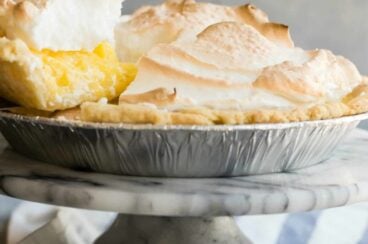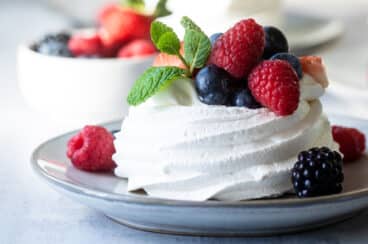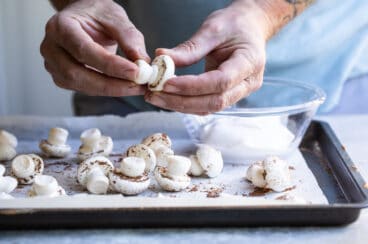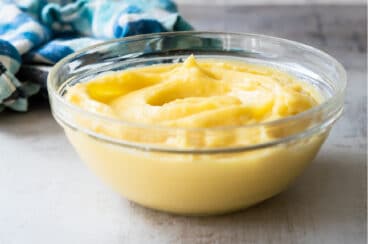This post may contain affiliate links. For more information, please see our affiliate policy.
Learn how to make Meringue, a crunchy topping with a soft interior, for elevated desserts all year round. Discover all the secrets to light and pillowy meringue, then put it to work on pies, tarts, cookies, pavlovas, and more.

Meggan’s notes
Meringue is an impressive dessert topping (or stand-alone masterpieces, as in pavlovas), but it’s easy to get frustrated. As a classically-trained chef with plenty of pastry experience under my belt, consider this my Meringue 101.
This how-to tutorial explains the basic meringue technique and is chock-full of my best tips and tricks for success. The secret to this easy meringue is to create a sugar syrup (from granulated sugar and water) so it incorporates more easily into the meringue instead of straight sugar.
This way, your meringue is always thick and glossy, ready for your next Lemon Meringue Pie, Baked Alaska, pavlova, or meringue cookies. Or try your hard at Schaum Torte, special individual meringue desserts created by German immigrants in Milwaukee, Wisconsin.
Table of Contents

At a Glance: Here is a quick snapshot of what ingredients are in this recipe.
Please see the recipe card below for specific quantities.
Meringue ingredients
- Egg whites: Both the age and temperature of the egg whites matter. Older eggs work better for meringue, and room-temp eggs whip up faster.
- Cream of tartar: Meringue needs an acid, and cream of tartar produces a more stable meringue than vinegar and lemon juice.
- Vanilla extract: For warmth and depth of flavor
- Granulated sugar
- Water
- Salt
How to make meringue
- Separate the egg whites and place in a very clean glass or metal bowl (plastic bowls can have a greasy film that prevents foaming). Try to separate the eggs without leaving even a trace of yolk in the whites as the fat in the yolk can prevent the whites from developing the volume you want.
- In a small saucepan over medium-high heat, bring sugar and water to boil and cook until mixture is slightly thickened and syrupy, about 3 to 4 minutes (235 degrees on a candy thermometer). Remove from heat and cover to keep warm.

- In a stand mixer fit with the whisk, or in a large bowl with an electric mixer, whip egg whites, cream of tartar, and salt together on medium-low speed until foamy, about 1 minute.

- Increase mixer speed to medium-high and whip until whites are shiny and soft peaks form, about 1 to 3 minutes.

- Reduce mixer speed to medium and slowly drizzle warm syrup (avoid the whisk attachment and sides of bowl). Add vanilla, increase speed to medium-high, and whip until mixture has cooled slightly and is very thick and shiny, about 3 to 6 minutes.

How to use this recipe for meringue
Preheat oven to 400 degrees. Pile the whipped meringue onto your warm dessert and bake until the peaks are gently browned, about 5 to 6 minutes. Or, brown with a handheld kitchen torch.

How to use this recipe for pavlova or meringue cookies
If you’re making pavlova or cookies, pipe, spoon, or form the meringue into the shape(s) you need right on a parchment-lined baking sheet and bake at 275 degrees until firm, about 30 minutes for cookie kisses, possibly longer for larger meringues. Let cool completely on a wire rack before serving.
Best Meringue Recipe tips
While making meringue is a fairly straightforward process, there are “some” things–okay, many things— to keep in mind to ensure successful meringue. It can be tricky, but you can do it!
- Humidity: Meringue works best when made on low humidity days. If it’s raining out or muggy, it may not be the best time. Meringue absorbs moisture in the air and turn limp or sticky.
- Age of eggs: Believe it or not, older eggs make better meringue. Look at the 3-digit code printed on the end of your carton, which gives each day of the year a number. If the eggs were packaged on January 1, the code would read 001. January 2, 002, and so on, all the way to December 31, which is 365. Get it?
- Temperature of eggs. Room temperature egg whites beat faster and higher than cold egg whites. Separate the eggs while cold, then let them warm up to room temp. Most importantly, if there’s even a bit of broken yolk in the whites, fish it out as best you can or start over—the fat in the yolk will impede the egg whites from whipping.
- Equipment: For maximum meringue volume, it is important to keep your egg whites and all of your equipment as free from residual fat or grease as possible. This means no grease in your mixing bowls and no drips of egg yolk in the whites. Use glass, stainless steel, or copper mixing bowls; avoid plastic bowls since they can be porous and have a greasy film after cleaning. Also, make sure the mixing bowl and whisk are both completely dry.
- Use an acid: Cream of tartar works better than lemon juice to stabilize meringue. If you’re not following this recipe, a good formula is to add ⅛ teaspoon of cream of tartar for every egg white you plan to use. If you don’t have any on hand, use ½ teaspoon lemon juice for every egg white. However, if you happen to have a copper-lined bowl, it’ll produce the same effect, so you don’t have to use any acid when using copper.
- Take your time: Don’t rush the process. Start out with the mixer at medium speed, and gradually increase the speed every few minutes. And don’t add the sugar syrup until the whites form soft peaks. Then the slower you add it, the better it’ll blend into the whipped whites.
- Use promptly: Once you stop beating the egg whites, it’s best to move quickly. The longer they sit before they’re baked in the oven, the more likely that they could sink and sag. Don’t let that air you worked so hard to achieve get out!
- Meringue without a mixer. This is how it was done in the old days, but it’s quite a workout, so I don’t recommend it. If you’re looking for an affordable mixer, try this one.
Troubleshooting meringue
How do you keep meringue from cracking? To avoid cracks in your baked meringues, be sure that your oven is fully warmed, but not too hot before baking the meringue.
Avoiding weeping meringue. First of all, if possible, make meringue pie on dry, low-humidity days.
Also, don’t over bake your meringue! Over baking causes the egg whites in the meringue to shrink and squeeze out small droplets of moisture. Always make sure to check on your pie at the minimum baking time.
Finally, make sure your pie filling is still warm when you top it with meringue, and spread the topping from end to end so it forms a good bond with the filling.
Flavoring meringue
If you’re making meringue for cookies or kisses, try adding a little flavor to the meringue at the stiff peak stage. Add a drop or two of citrus or peppermint essential oil, some sifted cocoa powder, finely ground nuts, coconut, or even Jello powder to give your cookies a subtle flavor.
How to store Meringue
Meringue-topped pies are best on the day you make them, and should be refrigerated after serving.
If you’re making crisp cookies, kisses, or pavlovas, store them in an airtight container at room temperature in a dry location.
Put your meringue to work
Fruit Dessert Recipes
Lemon Meringue Pie
Fruit Recipes
Schaum Torte
Baking Basics
Meringue Mushrooms
Baking Basics
Pastry Cream
Join Us

How to Make Meringue
Ingredients
- 3/4 cup granulated sugar
- 1/3 cup water
- 3 egg whites at room temperature (see note 1)
- 1/4 teaspoon cream of tartar (see note 2)
- ⅛ teaspoon Salt
- 1/4 teaspoon vanilla extract
Instructions
- Preheat oven to 400 degrees. Separate the egg whites and place in a very clean glass or metal bowl (plastic bowls can have a greasy film that prevents foaming). Try to separate the eggs without leaving even a trace of yolk in the whites as the fat in the yolk can prevent the whites from developing the volume you want.
- In a small saucepan over medium-high heat, bring sugar and water to boil and cook until mixture is slightly thickened and syrupy, about 3 to 4 minutes (235 degrees on a candy thermometer). Remove from heat and cover to keep warm.
- In a stand mixer fit with the whisk, or in a large bowl with an electric mixer, whip egg whites, cream of tartar, and salt together on medium-low speed until foamy, about 1 minute.
- Increase mixer speed to medium-high and whip until whites are shiny and soft peaks form, about 1 to 3 minutes.
- Reduce mixer speed to medium and slowly drizzle warm syrup (avoid the whisk attachment and sides of bowl). Add vanilla, increase speed to medium-high, and whip until mixture has cooled slightly and is very thick and shiny, about 3 to 6 minutes.
- Pile the whipped meringue onto your warm dessert and bake until the peaks are gently browned, about 5 to 6 minutes. Or, brown with a handheld kitchen torch.
Recipe Video
Notes
- Egg whites: Both the age and temperature of the egg whites matter. Older eggs work better for meringue, and room-temp eggs whip up faster.
- Cream of tartar: Meringue needs an acid, and cream of tartar produces a more stable meringue than vinegar and lemon juice.
Nutrition
Meggan Hill is a classically-trained chef and professional writer. Her meticulously-tested recipes and detailed tutorials bring confidence and success to home cooks everywhere. Meggan has been featured on NPR, HuffPost, FoxNews, LA Times, and more.




3/4 cup of sugar is 150g … not 50g.
Hi David, I’m really sorry about that confusion. I went in to the conversion program we use and it is now showing 150 mg. Thanks for catching it! -Meggan
Thank you so much for inspiration! I modified your Key lime pie recipe for Calamondin orange instead and topped with meringue as a loving nod to my Mom’s lemon meringue pie. BUT I’m having a problem: the pie weeps syrup !at the base! and gathers in the bottom of the pan, esp noticable the more slices are removed. I’ve made this many times now and haven’t found a cure. (It is not weeping meringue top and I am baking only on low humidity days.) Any suggestions, ideas or insight on a remedy? TIA 🙏
Easy to follow! Thank you!
It was helpful. Keep on posting!
How do you make the meringue stiffer if you don’t have anymore eggs?
Do you have to bake the meringue? I made a lemon pie and put in frig to cool. Wasn’t planning on baking again. wanted to use the egg whites left over.
Hi Denise, you just need to brown it in some way (you can bake it for 4 to 5 minutes per the recipe instructions, or you can hit it with one of those tiny pastry blow torches, if you have one. If you don’t brown it, it doesn’t get the chewiness that makes it meringue. I hope this helps. Thanks! -Meggan